Class B Fire Extinguishers Are Best Suited to Fight What Kind of Fires
When it comes to the types of fire extinguishers, at that place are five main types including moisture chemical, CO2, dry powder, foam and water. In guild to meet the electric current regulations, it is of import for you to have the verbal type of fire extinguisher that is needed for your premises. The need for different types of burn extinguisher arises from the different types of fuel that may kickoff a fire. The different types of fires caused by dissimilar fuels are classified as different classes of fire. As far equally the type of burn extinguisher needed at your business organisation bounds is concerned, it depends on the fire risk from various classes of fire.
It is of import for you lot to ensure that the right size and weight of fire extinguisher is available at your concern premises to meet the fire rubber regulations.
Fifty-fifty though the burn down extinguishers are classified into v master types, the dry pulverisation and water extinguishers accept different versions which means there are a total of eight different types of burn extinguishers to choose from. The eight dissimilar types of burn down extinguishers include specialist dry pulverization, standard dry powder, cream, h2o spray, water mist, water spray, wet chemical and carbon dioxide. In that location is no single fire extinguisher that tin can be used on all classes of fire.
Hither is a brief summary of different fire classes along with a reference nautical chart displaying the type of extinguisher for each glass of fire. Nosotros also share detailed caption of dissimilar types of burn down extinguishers below.
Classes of fire
There are half-dozen different types of fire classes and here is a detailed list covering types of burn down included in each form:
- Class A – fires caused by combustible materials including paper, fabric, wood and other flammable solids.
- Class B – fires caused by flammable liquids such as paint, turpentine or petrol amid others.
- Class C – fires caused by flammable gases including methane, butane or hydrogen among others.
- Class D – fires caused by combustible metals including potassium, aluminium or magnesium amid others.
- Class F – fires include those caused by cooking oils such equally a bit-pan fire.
- Electrical Fires – fires involving electric equipment but upon removal of the electrical item, the burn class is changed.
Types of Burn down Extinguishers
Foam Extinguishers
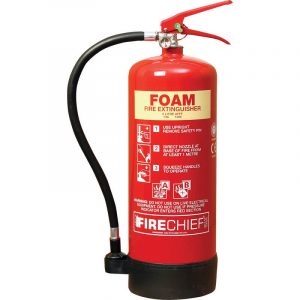 These are the nigh common type of burn extinguishers used for class B fires. However, these are h2o-based which means they these can also be used for grade A fires. The characterization colour is foam.
These are the nigh common type of burn extinguishers used for class B fires. However, these are h2o-based which means they these can also be used for grade A fires. The characterization colour is foam.
These fire extinguishers may exist used for fires caused by diverse organic materials including wood, coal, textiles, fabrics, cardboard and paper among other things as well every bit flammable liquids including petrol and paint.
This type of burn down extinguisher should non exist used for fires caused by combustible metals, kitchen fires and fires that involve electric equipment.
How This Extinguisher Works
These extinguishers work by creating a cooling effect on the fuel that is responsible for causing the burn. When information technology is poured on burning liquid, the burn down is extinguished by creating a bulwark between the fuel and the flame with the help of the foaming agent.
Foam extinguishers are needed by business organisation and premises where the building is made from diverse organic materials or in buildings where such organic materials are likely to exist found including warehouses, residential properties, hospitals, schools, offices and buildings storing combustible liquids. In simple terms, most of the buildings require the presence of foam or h2o extinguishers.
Location
This type of extinguisher should exist placed by the exits on floors that have been identified as a burn down take chances for class A or class B.
H2o Extinguishers
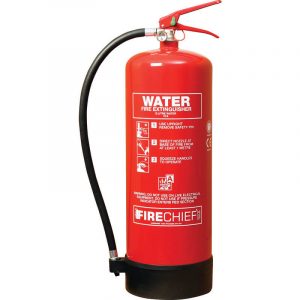 Water extinguishers are by and large used for grade A fire take chances. In about premises, information technology is necessary to accept either foam or water extinguishers. It has a bright red characterization.
Water extinguishers are by and large used for grade A fire take chances. In about premises, information technology is necessary to accept either foam or water extinguishers. It has a bright red characterization.
This type of extinguisher is used for fires caused by various organic materials including fabrics, textiles, coal, wood, cardboard and newspaper among others. It should not be used for kitchen fires, fires caused by combustible gas and liquids every bit well equally fires that involve electrical equipment.
How This Extinguisher Works
Equally far as the inner working is concerned, a water extinguisher works past having a cooling result on the liquid that causes the burning fuel to burn at a slower rate until the flames are completely extinguished.
The type of businesses or premises where these extinguishers are needed include buildings made of wood or organic materials or business premises containing certain types of organic materials such equally hospitals, schools, offices, warehouses and residential backdrop. Most of the buildings require either cream or water extinguishers.
Location
These extinguishers are required to be placed by the exit on floors that have been identified for class A fire risk.
What's different about h2o spray extinguishers?
This type of extinguisher comes equipped with a spray nozzle instead of a jet nozzle which means the h2o is able to cover much greater surface area quickly in order to put out burn more rapidly.
What's different about h2o mist extinguishers?
As the name suggests, this type of extinguishers come equipped with a different type of nozzle that is responsible for releasing extremely small-scale, microscopic water particles. This extinguisher nozzle releases micro particles that suffocate the fire and likewise go along the person using the extinguisher safety by creating a wall of mist which helps in reducing the feeling of heat.
Dry Pulverization Extinguishers
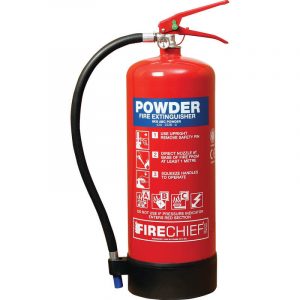 The standard dry out powder extinguishers are likewise known as ABC extinguishers as these can exist used for course A, class B and grade C fires. Withal, these should not be used in enclosed spaces every bit the dry powder in the extinguisher can exist easily inhaled. Also, information technology's non easy to clean upward the leftover residue once the fire is over. These can also be used for fires involving electric equipment. In that location are also special dry pulverization extinguishers that are typically used for fires caused past flammable metals. The label colour for this type of extinguisher is blue.
The standard dry out powder extinguishers are likewise known as ABC extinguishers as these can exist used for course A, class B and grade C fires. Withal, these should not be used in enclosed spaces every bit the dry powder in the extinguisher can exist easily inhaled. Also, information technology's non easy to clean upward the leftover residue once the fire is over. These can also be used for fires involving electric equipment. In that location are also special dry pulverization extinguishers that are typically used for fires caused past flammable metals. The label colour for this type of extinguisher is blue.
This type of burn down extinguisher may be used for fires caused past diverse organic materials including woods, coal, textiles, fabrics, cardboard and paper amid others. It may also be used for fires caused by flammable liquids including petrol and paint also equally combustible gases including acetylene and liquid petroleum gas. Whatever fires that involve electrical equipment up to 1000 Five may also be dealt with the help of this fire extinguisher.
Equally mentioned above, at that place are special dry pulverisation extinguishers but these are typically used only on flammable metals such every bit magnesium and titanium.
This type of fire extinguisher should not be used for fires that involve electrical equipment over 1000 V and fires that involve cooking oil.
Location
Garage forecourts, welding and flame cutting businesses and buildings with large boiler rooms are examples of premises using combustible gases for chemical processes where this type of fire extinguisher is required.
Moisture Chemical Extinguishers
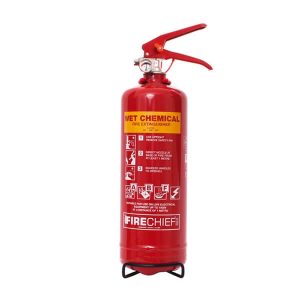 Wet chemic extinguishers are designed for utilise on Class F fires, involving cooking oils and fats. They tin can too be used on Class A fires although information technology is more usual to have a foam or water extinguisher for this type of fire run a risk
Wet chemic extinguishers are designed for utilise on Class F fires, involving cooking oils and fats. They tin can too be used on Class A fires although information technology is more usual to have a foam or water extinguisher for this type of fire run a risk
For fires involving cooking oils and fats (a Class F fire), a wet chemic extinguisher tin can be used. The wet chemic fire extinguisher can also be used on Grade A fire, simply foam or h2o extinguishers are more common. Dry powder extinguishers smother fires by forming a barrier between the fuel and source of oxygen. The label colour for this type of extinguisher is yellowish.
Moisture chemical extinguishers tin can besides exist used for fires acquired by various organic materials including wood, coal, textiles, fabrics, paper-thin and paper.
Location
This blazon of fire extinguisher needs to exist placed nearly to the source of the fire adventure in commerical kitchens and canteens.
Carbon Dioxide (CO2) Extinguishers
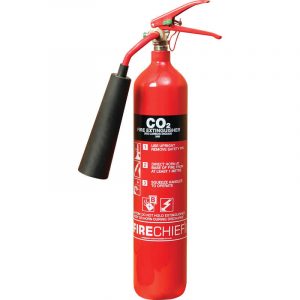 CO2 extinguishers are mainly used for electrical fire risks and are usually the principal burn extinguisher type provided in computer server rooms. They likewise put out Class B fires. CO2 extinguishers suffocate fires by displacing the oxygen the fire needs to burn down. This type of extinguisher has a black characterization.
CO2 extinguishers are mainly used for electrical fire risks and are usually the principal burn extinguisher type provided in computer server rooms. They likewise put out Class B fires. CO2 extinguishers suffocate fires by displacing the oxygen the fire needs to burn down. This type of extinguisher has a black characterization.
Location
CO2 extinguishers need to exist place most to the source of the burn risk or near the fire exits such as offices, kitchens, server rooms and premises with electrical appliances and equipment.
Our Services
If you are in need of burn extinguisher servicing, our accredited fire engineers will attend your sites at a time convenient to you. Contact us today to arrange a visit and make up one's mind on the future course of activeness.
Source: https://fire-risk-assessment-network.com/blog/types-fire-extinguisher/
0 Response to "Class B Fire Extinguishers Are Best Suited to Fight What Kind of Fires"
Post a Comment